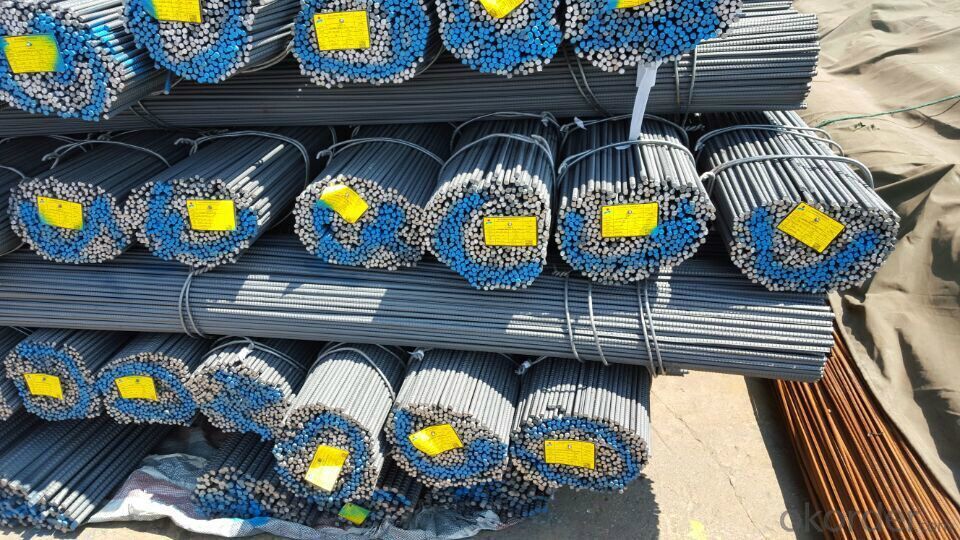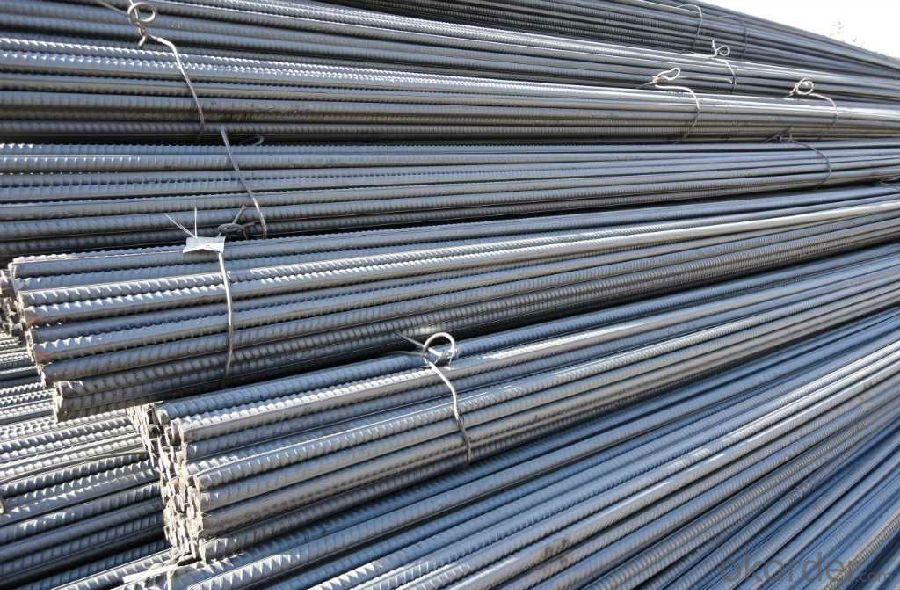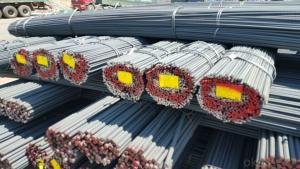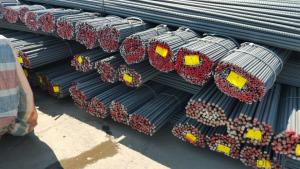Reinforcing Deformed Steel Bars in Grade HRB400
- Loading Port:
- Tianjin
- Payment Terms:
- TT OR LC
- Min Order Qty:
- 25 m.t.
- Supply Capability:
- 20000 m.t./month
OKorder Service Pledge
OKorder Financial Service
You Might Also Like
Item specifice
OKorder is offering high quality Hot Rolled Rebars at great prices with worldwide shipping. Our supplier is a world-class manufacturer of steel, with our products utilized the world over. OKorder annually supplies products to Africa, North American and Asian markets. We provide quotations within 24 hours of receiving an inquiry and guarantee competitive prices.
Product Applications:
Deformed bar is widely used in buildings, bridges, roads and other engineering construction. Big to highways, railways, bridges, culverts, tunnels, public facilities such as flood control, dam, small to housing construction, beam, column, wall and the foundation of the plate, deformed bar is an integral structure material. With the development of world economy and the vigorous development of infrastructure construction, real estate, the demand for deformed bar will be larger and larger.
Product Advantages:
OKorder's Hot Rolled Rebars are durable, strong, and resist corrosion.
Main Product Features:
· Premium quality
· Prompt delivery & seaworthy packing (30 days after receiving deposit)
· Corrosion resistance
· Can be recycled and reused
· Mill test certification
· Professional Service
· Competitive pricing
Product Specifications:
Manufacture: Hot rolled
Grade: HRB400 – HRB500
Certificates: ISO, SGS, BV, CIQ
Length: 6m – 12m, as per customer request
Packaging: Export packing, nude packing, bundled
Grade | Technical data of the original chemical composition (%) | ||||||
C | Mn | Si | S | P | V | ||
HRB400 | ≤0.25 | ≤1.60 | ≤0.80 | ≤0.045 | ≤0.045 | 0.04-0.12 | |
Physical capability | |||||||
Yield Strength (N/cm²) | Tensile Strength (N/cm²) | Elongation (%) | |||||
≥400 | ≥570 | ≥14 | |||||
Theoretical weight and section area of each diameter as below for your information:
Diameter(mm) | Section area (mm²) | Mass(kg/m) | Weight of 12m bar(kg) |
6 | 28.27 | 0.222 | 2.664 |
8 | 50.27 | 0.395 | 4.74 |
10 | 78.54 | 0.617 | 7.404 |
12 | 113.1 | 0.888 | 10.656 |
14 | 153.9 | 1.21 | 14.52 |
16 | 201.1 | 1.58 | 18.96 |
18 | 254.5 | 2.00 | 24 |
20 | 314.2 | 2.47 | 29.64 |
22 | 380.1 | 2.98 | 35.76 |
25 | 490.9 | 3.85 | 46.2 |
28 | 615.8 | 4.83 | 57.96 |
32 | 804.2 | 6.31 | 75.72 |
36 | 1018 | 7.99 | 98.88 |
40 | 1257 | 9.87 | 118.44 |
50 | 1964 | 15.42 | 185.04 |
FAQ:
Q1: Why buy Materials & Equipment from OKorder.com?
A1: All products offered by OKorder.com are carefully selected from China's most reliable manufacturing enterprises. Through its ISO certifications, OKorder.com adheres to the highest standards and a commitment to supply chain safety and customer satisfaction.
Q2: How do we guarantee the quality of our products?
A2: We have established an advanced quality management system which conducts strict quality tests at every step, from raw materials to the final product. At the same time, we provide extensive follow-up service assurances as required.
Q3: How soon can we receive the product after purchase?
A3: Within three days of placing an order, we will begin production. The specific shipping date is dependent upon international and government factors, but is typically 7 to 10 workdays.
Q4:What's your payment terms ?
A4:Mostly,we collect the money by T/T and LC at sight . We also accept time LC at 90/120 days sight.
Images


- Q:What is the difference between grade two and three grade steel?
- But from the definition we can see more of the same point, all belong to the common low alloy hot rolled ribbed steel bars; belong to (usually said that the rebar); can be used for engineering in reinforced concrete structure.
- Q:What is the lifespan of steel rebars in a corrosive environment?
- The lifespan of steel rebars in a corrosive environment can vary depending on several factors such as the severity of the corrosive environment, the quality of the steel used, and the presence of protective measures like coatings or cathodic protection. However, on average, steel rebars can last anywhere from 20 to 50 years in a corrosive environment before significant corrosion damage occurs.
- Q:How are steel rebars protected against rust and corrosion?
- Steel rebars are protected against rust and corrosion through the application of protective coatings such as epoxy, zinc, or a combination of both. These coatings act as a barrier against moisture and oxygen, which are the main causes of rust. Additionally, rebars can also be galvanized or stainless steel, which inherently have higher resistance to rust and corrosion.
- Q:What is the process of inspecting steel rebars for quality control?
- The process of inspecting steel rebars for quality control involves several steps. First, the rebars are visually inspected for any visible defects such as cracks, rust, or surface irregularities. Next, the rebars are measured to ensure they meet the required dimensions and tolerances. This includes checking their length, diameter, and weight. Additionally, rebars may undergo non-destructive testing techniques like ultrasonic testing or magnetic particle inspection to detect any internal flaws or discontinuities. Finally, samples may be taken from the batch of rebars and tested for mechanical properties such as tensile strength, yield strength, and elongation to verify their quality.
- Q:How do steel rebars affect the overall seismic performance of buildings?
- Steel rebars play a crucial role in enhancing the overall seismic performance of buildings. These reinforced bars, when properly integrated into the structural system, provide significant strength and ductility to the building, allowing it to withstand seismic forces more effectively. One of the key benefits of steel rebars is their ability to increase the tensile strength of concrete structures. Concrete is strong in compression but weak in tension. By placing steel rebars within the concrete, the tensile strength is greatly improved, preventing the concrete from cracking or failing under the stress of seismic forces. In the event of an earthquake, steel rebars help distribute the seismic forces throughout the structure, minimizing localized damage and ensuring a more uniform response. The rebars act as a network of interconnected elements, transferring the energy created by the earthquake to the surrounding areas, thereby reducing the vulnerability to localized failures. Moreover, steel rebars enhance the ductility of the building, which is the ability to deform without losing structural integrity. During an earthquake, buildings experience significant lateral forces, and the ductility provided by the rebars allows the structure to absorb and dissipate these forces through controlled deformation. This prevents sudden and catastrophic failure, giving occupants more time to evacuate safely. Additionally, steel rebars can be strategically placed in critical areas of the building, such as at beam-column connections, where the highest stresses occur during an earthquake. By reinforcing these vulnerable points, the rebars ensure that the building maintains its structural integrity and remains resistant to collapse. In summary, steel rebars significantly improve the overall seismic performance of buildings by increasing tensile strength, distributing seismic forces, enhancing ductility, and reinforcing critical areas. Their integration into the structural system helps mitigate the potential for damage and ensures the safety of occupants during seismic events.
- Q:What are the precautions to be taken while welding steel rebars?
- When welding steel rebars, there are several precautions that need to be taken. First and foremost, it is crucial to wear appropriate personal protective equipment such as a welding helmet, gloves, and a protective apron to shield against sparks, heat, and UV radiation. Additionally, proper ventilation in the work area is necessary to prevent the accumulation of harmful fumes and gases. It is important to ensure that the rebar is clean and free from any contaminants or coatings that could affect the quality of the weld. Welding should only be performed by trained and qualified individuals who understand the specific techniques and settings required for welding rebars. Finally, regular inspections of the welds should be conducted to ensure their integrity and strength.
- Q:How do steel rebars provide strength to concrete structures?
- Steel rebars provide strength to concrete structures by acting as reinforcement. When embedded within the concrete, rebars enhance its tensile strength, which is otherwise low. As concrete is strong in compression but weak in tension, the rebars resist the tensile forces that can cause cracking or failure in the structure. By distributing and absorbing these tensile forces, steel rebars increase the overall strength, durability, and structural integrity of the concrete.
- Q:What is the lifespan of steel rebars in concrete structures?
- The lifespan of steel rebars in concrete structures can vary depending on several factors. Generally, steel rebars are designed to provide durability and strength to concrete structures. With proper design, construction, and maintenance, steel rebars can last for several decades or even up to a century in concrete structures. One crucial factor influencing the lifespan of steel rebars is the quality of materials used. High-quality rebars manufactured with corrosion-resistant coatings or stainless steel tend to have a longer lifespan compared to regular carbon steel rebars. Additionally, the quality of concrete used and its ability to protect the rebars from moisture and corrosive agents is also important. Environmental conditions play a significant role in determining the lifespan of steel rebars. Exposure to harsh climates, such as areas with high humidity, saltwater, or acidic environments, can accelerate corrosion and reduce the lifespan of the rebars. Adequate protective measures, such as proper concrete cover thickness, waterproofing, and the use of corrosion inhibitors, can help extend the lifespan of steel rebars in such conditions. Maintenance and inspection are essential to ensure the longevity of steel rebars in concrete structures. Regular inspections for signs of corrosion, cracking, or damage should be conducted, and any necessary repairs or protective measures should be undertaken promptly. In some cases, periodic coating or rebar replacement may be required to maintain the structural integrity of the concrete elements. In summary, the lifespan of steel rebars in concrete structures can range from several decades to over a century, depending on various factors such as material quality, environmental conditions, and proper maintenance. By employing appropriate design, construction, and maintenance practices, the lifespan of steel rebars can be significantly extended, ensuring the long-term integrity and durability of the concrete structure.
- Q:What are the different types of steel rebars used in beams and columns?
- There are primarily two types of steel rebars used in beams and columns: mild steel rebars and high-strength rebars. Mild steel rebars are commonly used in general construction projects and have a lower yield strength. On the other hand, high-strength rebars, also known as deformed rebars, have a higher yield strength and are typically used in structures that require greater load-bearing capacity.
- Q:How do steel rebars affect the constructability of projects in environmentally sensitive areas?
- Steel rebars can have a significant impact on the constructability of projects in environmentally sensitive areas. Their use can present challenges in terms of excavation and foundation work, as well as potential disturbance to delicate ecosystems. Additionally, the production and transportation of steel rebars can contribute to carbon emissions and other environmental concerns. Therefore, alternative construction materials or techniques may need to be considered to minimize the environmental impact and ensure sustainable development in these areas.
1. Manufacturer Overview |
|
|---|---|
| Location | |
| Year Established | |
| Annual Output Value | |
| Main Markets | |
| Company Certifications | |
2. Manufacturer Certificates |
|
|---|---|
| a) Certification Name | |
| Range | |
| Reference | |
| Validity Period | |
3. Manufacturer Capability |
|
|---|---|
| a)Trade Capacity | |
| Nearest Port | |
| Export Percentage | |
| No.of Employees in Trade Department | |
| Language Spoken: | |
| b)Factory Information | |
| Factory Size: | |
| No. of Production Lines | |
| Contract Manufacturing | |
| Product Price Range | |
Send your message to us
Reinforcing Deformed Steel Bars in Grade HRB400
- Loading Port:
- Tianjin
- Payment Terms:
- TT OR LC
- Min Order Qty:
- 25 m.t.
- Supply Capability:
- 20000 m.t./month
OKorder Service Pledge
OKorder Financial Service
Similar products
New products
Hot products
Related keywords





























